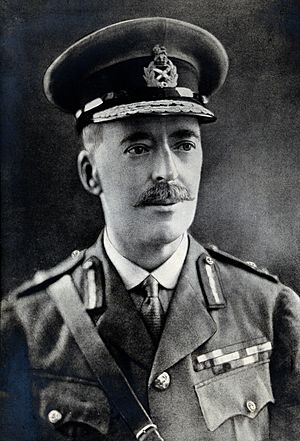William Boog Leishman facts for kids
Quick facts for kids
William Boog Leishman
|
|
|---|---|

Sir William Boog Leishman
|
|
| Born | 6 November 1865 Glasgow, Scotland |
| Died | 2 June 1926 (aged 60) London, England |
| Buried |
Highgate Cemetery
|
| Allegiance | |
| Service/ |
|
| Years of service | 1887–1926 |
| Rank | Lieutenant-General |
| Commands held | Director General Army Medical Services |
| Battles/wars | North-West Frontier First World War |
| Awards | Knight Commander of the Order of the Bath Knight Commander of the Order of St Michael and St George Knight Bachelor Mentioned in Despatches (3) Legion of Honour (France) Army Distinguished Service Medal (United States) |
Sir William Boog Leishman (born November 6, 1865 – died June 2, 1926) was a very important Scottish doctor and scientist. He worked for the British Army as a medical officer. He was a pathologist, which means he studied diseases and how they affect the body. From 1923 to 1926, he was the Director-General of Army Medical Services, leading all the medical services for the army.
Contents
A Life of Discovery
William Leishman was born in Glasgow, Scotland. He went to Westminster School and then studied at the University of Glasgow. After his studies, he joined the Royal Army Medical Corps as a doctor.
He served in India, where he did important research on diseases like enteric fever (a type of fever) and kala-azar. Kala-azar is a serious disease caused by tiny parasites.
In 1897, he came back to the United Kingdom and worked at the Victoria Hospital in Netley. By 1900, he became a professor at the Army Medical School.
Leishman's Stain
While at the Army Medical School, Leishman created a special way to stain blood. This stain helped doctors see tiny parasites like those that cause malaria under a microscope. His method was a simpler version of an older technique called the Romanowsky stain. It used a mix of two colors, methylene blue and eosin, and became famous as Leishman's stain.
Leishman-Donovan Bodies
In 1901, Leishman was looking at samples from a patient who had died from kala-azar. He saw tiny, oval-shaped bodies in the patient's spleen. He wrote about his discovery in 1903.
Around the same time, another doctor named Charles Donovan also found these same tiny bodies in other kala-azar patients in India. Because of their separate discoveries, these tiny invaders are now called Leishman–Donovan bodies. We now know they are a type of protozoa (a very tiny living thing) that causes kala-azar, specifically named Leishmania donovani.
Sir Ronald Ross, another famous scientist, was very impressed by Leishman's work. He decided to give the parasites that cause kala-azar their own special group, or genus, called Leishmania.
Other Important Work
Leishman also helped figure out the life cycle of a tiny spiral-shaped germ called Spirochaeta duttoni. This germ causes a disease called African tick fever.
Working with another scientist named Almroth Wright, Leishman also helped create a very effective shot (inoculation) to protect people from typhoid fever.
He was the president of the Royal Society of Tropical Medicine and Hygiene from 1911 to 1912. Later, he became the Director General of the Army Medical Services from 1923 until 1926.
Sir William Leishman is buried in the eastern part of Highgate Cemetery in London.
How He's Remembered
Sir William Leishman's name is carved into a special stone frieze at the London School of Hygiene & Tropical Medicine. This school was built in 1926, and 23 names of important people who helped improve public health and tropical medicine were chosen to be honored there.
A special fund was started to remember him, and today, the Leishman Memorial Prize is given out every year. This prize honors important work in medicine, surgery, or other related sciences done by members of the Royal Army Medical Corps.
See also
- Leishman stain
- Leishmaniasis
- Romanowsky stain


